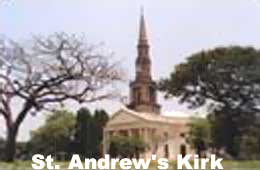 The St. Andrew's Church, Egmore is popularly referred
to as 'The Kirk'. It was consecrated in 1821 AD especially for the
Scottish Community in Chennai. The church was the result of efforts
of Major Thomas Fort de Havilland and Colonel James Caldwell. St
Andrew's Kirk was built to serve the members of the Scottish Church
serving in the East India Company.
It is one of the finest examples of Georgian Church architecture
in Asia and was modeled on the plan for St.Martin's Lane, London.
The East India Company had borne the expense of the construction
of St George's Church of England and therefore decided to construct
a church of the sister kingdom, Scotland. Thus St. Andrew's Kirk
came into being.
The plan was not suited for the hot and humid climate. The proposed
roof was a big challenge to implement. Financial constraint was
also there. The dome had to be built with the help of masonry, which
suited the local climatic conditions. A Bishop of the Church objected
to the construction of steeples outside of Scotland saying that
it was "unusual and unconstitutional" practice.
The height of the dome of the St. Andrews Kirk is 51.5 ft in diameter
from inside. Sixteen fluted Corinthian columns support it. The dome
was constructed using the 'Syrian masonry' technique. The dome was
painted with lapis lazuli shade of blue. It is believed to be one
of the few in the world to be supported by columns of such huge
height. The interiors are done with woodwork of mahogany and black
and white chequered marble floor, which adds to the beauty of this
church.
The land was purchased because of the low land value and its proximity
to the Fort St. George. But the land was on marshy lowland and was
subject to sinking and flooding. The 14 ft foundation of the Kirk
sits on a bed of pottery and brick wells 9 ft deep. The wells were
sunk into the marshy sand by first weaving a wicker ring to sit
under the brick or pottery ring. The walls of the well were built
with specially made curved bricks or pottery rings cemented with
watery mortar over it. The entire tube was then bound completely
with coir rope.
The well digger gets into this tube to excavate the hole beneath,
taking utmost care not to upset the perpendicularity of the constructed
cylinder. The total of 150 wells were set close to each other and
were filled with material whose volume did not alter in water. The
foundation was created as a strong series of connected low vaults
that could serve as catacombs if necessary in the future. The building
was kept in equilibrium as all the wells were placed on the same
type of surface and would all be affected uniformly. On the April
6, 1818, Rev. Doctor John Allen D.D laid the foundation stone of
the church. The circular central congregation hall is cool and airy.
The beauty and grace of the church is by lovely stuccowork of Madras
Chunnambu or lime stucco renowned for its superiority. The pillars
and walls are decorated with a relief of grapes nestled in leaves.
The two enormous stained glass panels glow on the back wall depicting
scenes from the Bible. They are examples of excellent artistry by
'W&J Jkier, artists in Stained Glass, Glasgow, Scotland'. 15
enormous olive green and gold pipes are arranged in a beautiful
vertical and lateral pattern to make an astounding organ. Behind
the pipes, connected mass of levers, hinges, pipes, chords and beams
are placed that made this complex instrument work.
A narrow stairway leads to the roof of the main structure. There
is the bald top of the dome. Two new stainless steel bands reinforce
the dome, which had begun to crack. At the front end is the steeple
itself. A bell is suspended from a large beam in a square room having
a beautiful sound. An interesting story is associated with the bell.
The original bell was 4 m in diameter and was meant especially for
this Church. It was cast by an experienced bell founder from Bengal,
in a Powder foundry, which is otherwise used only for military purpose.
The British bureaucracy had, however, refused to spare the founder
of the establishment to cast the bell. The bell was duly hung and
tolled for the first time at the funeral of the aged pastor. Very
soon a controversy surrounded the bell, following the complaint
by the jealous powder- mill founder who was sidelined from this
project. The bell was brought down and the Military Board ordered
an inquiry. The bell was ordered to be sold and was broken up and
replaced by the existing one.
|


